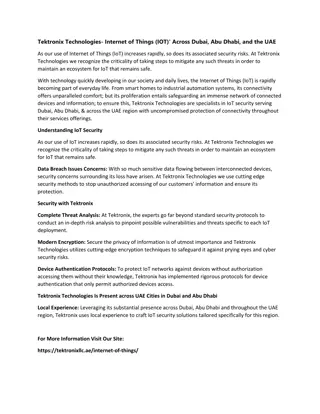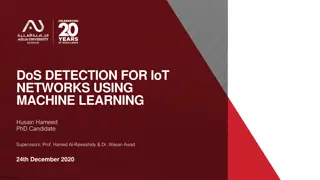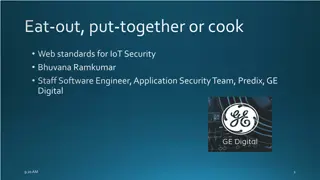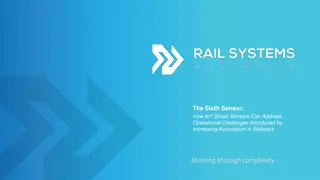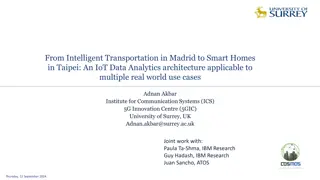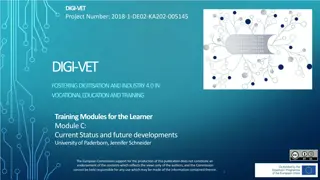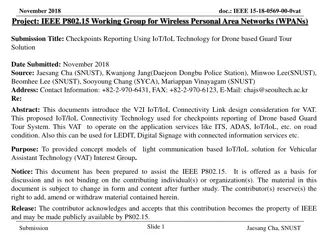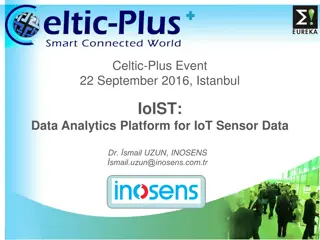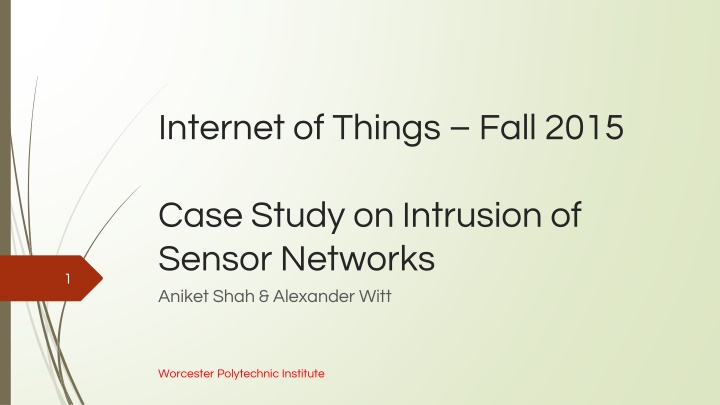
Case Study on Intrusion of Sensor Networks in Internet of Things
Explore the vulnerability of sensor networks in Internet of Things, focusing on compromising VANET nodes, communication security, and the role of Electronic Control Units (ECUs) in automotive systems. Learn about the research conducted at Worcester Polytechnic Institute to address these security challenges.
Download Presentation

Please find below an Image/Link to download the presentation.
The content on the website is provided AS IS for your information and personal use only. It may not be sold, licensed, or shared on other websites without obtaining consent from the author. If you encounter any issues during the download, it is possible that the publisher has removed the file from their server.
You are allowed to download the files provided on this website for personal or commercial use, subject to the condition that they are used lawfully. All files are the property of their respective owners.
The content on the website is provided AS IS for your information and personal use only. It may not be sold, licensed, or shared on other websites without obtaining consent from the author.
E N D
Presentation Transcript
Internet of Things Fall 2015 Case Study on Intrusion of Sensor Networks 1 Aniket Shah & Alexander Witt Worcester Polytechnic Institute
Introduction 2 V Vehicular A Ad-Hoc Net emerging areas in the world of Internet of Things (IoT) Networks (VANETs) are one of the technological It is a subset of M Mobile A Ad-Hoc Net with Vehicle to Vehicle (V2V) communication and forms a part of the Intelligent Transport System Networks (MANETs), which deals One of the focus areas within VANET research deals with security of the nodes (vehicles) and the communication security Here, we discuss the compromising of VANET nodes, the actions and mannerisms to do so and the possible solutions to counter the same Worcester Polytechnic Institute
Introduction 3 Automobiles today, contain a number of different electronic components networked together that are responsible for monitoring and controlling the state of the vehicle Modern automobiles contain upto 50 Electronic Control Units (ECUs ECUs) networked together with the overall safety of the vehicle depending on near real time communication between these various ECUs Electronic Control Units When electronic networked components are added to any device, questions of the robustness and reliability of the code running on those devices can be raised; especially for vehicular networks Worcester Polytechnic Institute
Introduction 4 In this study, we talk about bringing accessibility to automotive systems to security researchers in an open and transparent way The fact that a risk of attack exists but there is not a way for researchers to monitor or interact with the system is distressing Provide a framework Provide a framework that will allow the construction of such tools for automotive systems Allow researchers to demonstrate the threat to automotive systems in a concrete way as well as write monitoring and control applications to help alleviate this threat Worcester Polytechnic Institute
Electronic Control Units (ECUs) 5 ECUs are special embedded devices with specific purposes to sense the environment around them and take action to help the automobile ECUs communicate with one another by sending Controller Area Network Network (CAN CAN) packets Controller Area Packets are broadcast to all components on the bus; components decide whether packets intended for them There is no source identifier or authentication built into CAN packets, making it is easy for components to sniff the CAN network, masquerade as other ECUs and send CAN packets Worcester Polytechnic Institute
Electronic Control Units (ECUs) 6 Makes reverse engineering traffic more difficult Reason: It is impossible to know which ECU is sending or receiving a particular packet By examining the CAN in which the ECUs communicate, it is possible to send proprietary messages to the ECUs proprietary messages to the ECUs, take some action or even completely reprogram the ECUs All relevant ECUs are on CAN-H and CAN-L buses Worcester Polytechnic Institute
Types of ECUs 7 Engine Control Module (ECM) Skid Control ECU (i.e ABS System) Power Management Control Module Airbag ECU Transmission Control ECU Combination Meter Assembly Main Body ECU Driving Support ECU Power Steering ECU Parking Assist ECU Certification ECU (i.e. Smart Key ECU) Seat belt Control ECU Worcester Polytechnic Institute
Controller Area Network (CAN) 8 CAN bus is used for communication between the different ECUs CAN packets are split into two sections: Normal Normal CAN packets Diagnostic Diagnostic CAN packets There are components such as a length field and checksums at a lower level in the protocol stack The identifier is used as a priority field, the lower the value, the higher the priority Helps ECUs determine whether they should process CAN packet or not; necessary since CAN traffic is broadcast in nature Worcester Polytechnic Institute
Normal CAN 9 Normal packets are sent from ECUs and can be seen on the network at any given time Either broadcast message or specific ECU commands CAN packets do have a CAN ID associated with them but for normal CAN packets, each ECU independently determines whether they are interested in a message based on the ID One complication arises when trying to simulate the traffic on CAN is that the CAN network is broadcast in nature, one cannot tell the source or intended destination of any of the messages Worcester Polytechnic Institute
Diagnostic CAN 10 The other type of CAN packets seen in automotive systems are diagnostic packets These packets are sent by diagnostic tools ,used to communicate with and interrogate an ECU; typically not be seen during normal operation of the vehicle In the case of diagnostic packets, each ECU has a particular ID assigned to it, unlike normal packets, and are totally proprietary Diagnostic packet formats typically follow pretty strict standards but unsure whether ECUs will actually respect them Worcester Polytechnic Institute
CAN Communication 11 EcomCat EcomCat - C software to read/write data into CAN bus Mostly single commands sent but there is the option of continuous data transfer With the scene of compromising VANET nodes, we look at injecting CAN packets into the bus to disrupt regular (expected) communication Many problems associated in trying to make the vehicle perform actions by injecting packets into the CAN bus Worcester Polytechnic Institute
Problems in CAN Communication 12 Everything cannot be controlled via the CAN bus directly Takes a lot of reverse engineering to locate specific packets that are requests from one ECU for another ECU Even once CAN IDs are identified, there are two problems that may occur: You can send fake packets send fake packets, which may confuse the recipient ECU with conflicting data. The receiving ECU may have safety features built into it that makes it ignore the packets ignore the packets you are sending. Worcester Polytechnic Institute
Problems in CAN Communication 13 There can be a lack of response sent if there is contention on the bus ack of response or complete disregard for packets The ECU, for which packets are forged, continues sending traffic on the bus, unless it is completely removed from the network As a result, ECUs consuming the data being sent may receive conflicting data conflicting data receive Worcester Polytechnic Institute
Attacks on ECUs 14 Safety critical attacks against modern automobiles generally require three stages:- Stage 1 Stage 1: Consists of an attacker remotely gaining access internal automotive network remotely gaining access to an Stage 2 Stage 2: Involves injecting messages attempt to communicate with safety critical ECUs injecting messages onto the network in an Stage 3 Stage 3: Involves reverse engineering the messages reverse engineering the messages on the network to perform some physical action; make the target ECU behave in a way that compromises vehicle safety compromises vehicle safety Worcester Polytechnic Institute
Different Remote Attack Surfaces 15 Passive Anti Theft System (PATS) Tire Pressure Monitoring System (TPMS) Remote Keyless Entry / Start (RKE) Bluetooth Radio Data System Telematics / Cellular / Wi Fi Internet / Apps Worcester Polytechnic Institute
Attacks via CAN packets 16 Once the attacker has completed stage 2 and injected messages into the network, he can overwrite commands using code and corrupt data sent to the ECUs via the CAN bus The attacks via the CAN bus can be done using either Normal packets or the Diagnostic packets Attacks via the Normal CAN packets affect mainly the smaller or the less important ECUs while the attacks via the Diagnostic CAN packets have serious effects on vehicular safety Worcester Polytechnic Institute
Attacks - Normal CAN packets 17 Speedometer Odometer On-board Navigation Limited Steering Steering Braking Acceleration Worcester Polytechnic Institute
Attacks - Diagnostic CAN packets 18 Security Access Brake engaging Lights Engine Kill Horn Door Lock Fuel Gauge Worcester Polytechnic Institute
Defending against Attacks 19 CAN messages provide a way to put the ECUs in various states All of the messages can be issued on a periodic basis while the car is in any state Additionally, the frequency of normal CAN packets is very predictable Different ways to counter remote attacks: Secure Remote Endpoints CAN Injection Mitigations Message Cryptography Network Architecture Attack Detection Worcester Polytechnic Institute
Defending against Attacks 20 Secure Remote Endpoints Secure Remote Endpoints - Minimize the attack surface and lock down remote services; complete security is not achievable CAN Injection Mitigations CAN Injection Mitigations - Use of good OS to block mitigations Message Cryptography Message Cryptography - Cryptographically verify CAN messages to make injection difficult Network Architecture Network Architecture -Isolate those ECUs with remote functionality from those that control safety critical features Attack Detection Attack Detection - Add attack detection and prevention technology into critical CAN networks Worcester Polytechnic Institute
Case Study 21 Target Vehicle: Jeep Cherokee 2014 Aim: Aim: Expose vulnerabilities within the security of the vehicle and provide way for more secure connected cars Reasons for choosing vehicle: large attack surface simple architecture many advanced physical features that would make it an ideal candidate to try to continue further research Worcester Polytechnic Institute
Network Architecture 22 Radio connected to both CAN buses Access to CAN-IHS & CAN-C networks Minimal architectural restrictions Worcester Polytechnic Institute
Remote Attack Surfaces 23 Potential entry points and their communication channels Worcester Polytechnic Institute
Uconnect System 24 Radio system manufactured by Harman Kardon as the sole source of infotainment, navigation, Wi-Fi, apps, Cellular connectivity Contains a microcontroller and software that allows it to communicate with other electronic modules in the vehicle over the CAN-IHS Runs the QNX operating system on a 32-bit ARM processor Contains the following file systems: Initial Program Loader (IPL IPL) IFS IFS Embedded Transaction File System (ETFS Multimedia Card (MMC MMC) ETFS) Worcester Polytechnic Institute
Compromising the Jeep 25 Charlie Miller and Chris Valasek; authors of the papers on the hack on the Jeep, provide various methods to do so Jailbreak of the Uconnect System Jailbreak of the Uconnect System Exploiting the D Exploiting the D- -Bus service Bus service Cellular Exploitation Cellular Exploitation Scanning more vulnerable vehicles using the Jeep cellular access Worcester Polytechnic Institute
List of Vehicles Scanned 26 List of Vehicles that the authors could connect with without authentication Scanned using the cellular access of Jeep s Sprint Uconnect system Worcester Polytechnic Institute
Attack using CAN messages on Jeep 27 Normal CAN packets Accessed Turn signals Accessed Locks Accessed RPMS Turn signals using SPI communication SPI communication Locks using CAN CAN- -IHS bus IHS bus RPMS using CAN CAN- -C bus C bus Diagnostic CAN packets Killed engine Killed engine in session with Mechanical tool Killed brakes Killed brakes in session with ABS ECU Killed Steering Killed Steering in session with PAM Mechanical tool ABS ECU PAM and ABS ECUs ABS ECUs
Case Study Conclusion 28 Demonstrated a remote attack that can be performed against many Fiat-Chrysler vehicles Number of vehicles that were vulnerable were in the hundreds of thousands and it forced a 1.4 million vehicle recall 1.4 million vehicle recall by FCA as well as changes to the Sprint carrier network Remote attack could be performed anywhere in the United States anywhere in the United States and requires no modifications to the vehicle or physical interaction by the attacker or driver performed against vehicles located
Conclusion 29 Without security, if an attacker (or even a corrupted ECU) can send CAN packets, it will affect the safety of the vehicle Listed out methods for communication within a single node of VANET and problems associated with it Identified the features that the car possesses which may help in taking physical control of the vehicle Discussed Case study regarding the Jeep Cherokee to demonstrate the impact of lack of security in VANET nodes Worcester Polytechnic Institute


